Cladding and facades
If the overall form of a building suggests how it speaks to its surroundings, the materiality of walls is the language with which that conversation takes place.
Cladding and facades formed from prepainted metal can be expressed to complement a wide range of buildings and environments, and are increasingly used in combination with other materials, particularly glass, timber and other metals.
Such applications provide modern, smooth lines, and accentuate the form of high-profile buildings. Efficient, attractive, yet functional, it has been said that prepainted metal has an honesty about it that appeals to designers and occupants alike.
From the ubiquitous modern smooth silver box, through innumerable colour combinations, right back to its roots in the corrugated walls of agricultural buildings and factories, prepainted metal can be a base element or a highlight.
Intelligent use of bright or muted, contrasting or complementary, multicoloured or monotonal facades can help to articulate the building. This can be combined with profiled textures to create dramatic or subtle effects on the way a building appears.
Prepainted cladding systems are also being applied to specific areas of larger buildings or in smaller properties where the intrinsic benefits—thermal and acoustic insulation, ecological performance and durability—are equally applicable.
Everywhere there is a space to enclose, prepainted metal can and does play its part, providing not only flexibility in design and aesthetics, but cost-effectiveness and improved long-term performance.

Roofing
The commercial and practical benefits of prepainting for roofing and over-roofing applications are widespread.
Lightweight, sustainable systems are highly effective for meeting strict quality and environmental standards required for industrial building regulations, while enabling rapid construction.
Typically manufactured in aluminium or steel as panels, prepainted solutions are used to fulfil both structural and architectural requirements. Meanwhile, thanks to an array of colours of different finishes, aesthetic aspects are also covered.
In the residential market, architectural panels that imitate tiles, shakes, shingles or slate when installed, have proved popular with developers and accelerated the shift to prepainted metal roofing.
Indeed, several new types of seaming methods, styles and colours have been developed to offer a broad range of prices as well as aesthetic choices. Many styles and colours are available and adapted according to existing shingle colours.
It is important to note, however, that local building codes and neighbourhood interests should be addressed when considering any roofing solution.
Finally, modern metal roofing often carries a warranty of up to 30 years, making it an extremely low risk, reliable and cost-effective way to future-proof a building.

Components
Prepainted metal can be formed into any number of shapes for flashings which finish off the main cladding systems. It is also widely used for rainwater goods, including gutters and downpipes, where durable coating can be specified on the internal side to further enhance durability.
In both rainwater goods and in flashings, using the same coated product as the rest of the cladding or roofing ensures the same high level of durability and uniform weathering between components.
Even when prepainted metal has not been used for the main elements, it is often used for rainwater goods due to the high durability, dimensional tolerances and range of finishes available.
Other applications include doors and shutters, especially as a skin for composite personnel and house doors which benefit from increased dimensional stability compared to alternatives.
From domestic garage doors to shutters on industrial and warehouse buildings, prepainted metal is becoming increasingly ubiquitous as a cost-effective and sustainable solution.

Internal parts
For internal applications in buildings, prepainted metal is often used as a lining material in its own right. Examples include the lining of tunnels or station or airport concourses, where it provides a cost-effective high-quality smooth white surface which reflects light well to give excellent interior lighting conditions.
Since internal environments tend to be relatively benign, a coating with minimal corrosion resistance is often sufficient. However, it’s important to remember that building components can be subjected to outdoor exposure during construction, so some level of corrosion protection is often required.
Prepainted metal is widely used for ceiling systems, both for suspension strips and for the tiles themselves. The exceptionally smooth, high-quality finish is especially favoured in clean environments.
When used in ceilings and for the inner leaf of walls, the prepainted metal is often perforated to allow sound to travel into dense insulation, providing a high level of sound deadening.
Where internal partitions are required, such as cold stores or controlled environment rooms prepainted metal is often used on insulated sandwich panels suspended inside the main building.
In such cases, prepainted metal is used for both skins of the panels with a highly insulating core sandwiched between. Panels are designed with the minimum of detail to avoid places where dust and dirt can accumulate.
For smaller cool-rooms and walk-in fridges, prepainted metal is again used for both interior and exterior, with the smooth high-quality finish easy to clean, which also makes it a hygienic option for toilet cubicles. Elsewhere, the magnetic effect of prepainted steel can be put to good use in office partitioning.
Further internal applications where prepainting adds value include light fittings, heating, ventilation and air conditioning equipment. It is also widely used for shop fittings, doors, lifts and cable ducting.

